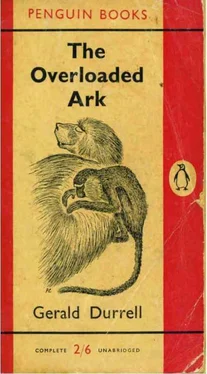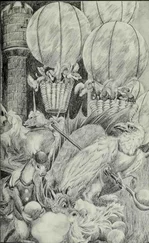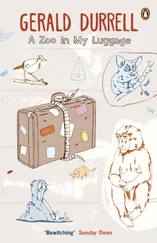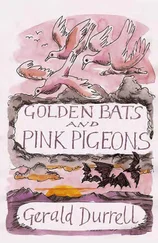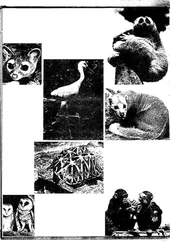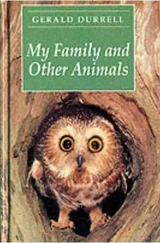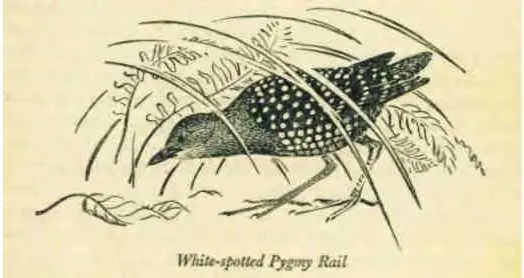
Turning to the girl I asked her how much she wanted for her specimens.
“Two two shillings, Masa,” she replied, meaning two shillings each.
“You hear?” I asked the boys. “Dis picken say she want two two shilling for dis bird. Na fine price dat: she get good bird, she done catch um softly softly, he no get wound, and she no bring um with rope for ’e foot. Because she savvay catch beef pass you all I go pay her five five shillings for dis very good beef.”
“Eh . . . aehh!” groaned the boys in envy and astonishment. The girl, who had not understood what was being said, was so amazed that I should pay her more than twice what she had asked that she clutched the money to her chest and fled the compound as fast as her fat little legs could carry her, in case I should change my mind. The boys followed in a chattering gesticulating group. From that day onwards the birds brought in were excellent, with one or two exceptions, and the boys of the village waxed fat on the proceeds of their sales, and my cages started to fill with some lovely specimens.
The boys had two methods of catching birds and, although both were effective, the best was the use of what was known as “lubber”. In the forest grew a certain vine, and on being cut this yielded a copious flow of thick white sap. The boys would collect this as it ran, as fast as blood, from the wounded vine, and when they had collected about half a cupful they would place it over a slow fire, having first mixed in the juice of a curious red fruit which tasted exactly like lemon. After boiling for a couple of hours this brew would be set aside to cool, and left overnight. In the morning it would be like a thick, resilient paste, extraordinarily sticky. Then the trappers would get the long slender midribs from a palm tree and coat them with this mixture. Going to certain small forest pools at which they knew the birds would congregate, they would then stick groups of these ribs in the sand in a fan shape. For some curious reason the birds, on coming down to drink, would rather perch on these twigs than on the sand. Landing on one the bird would find that its feet were held fast, and in its fluttering to get free it would fall forwards or backwards on to the other twigs, which would then stick all over its plumage, rendering it helpless. After a few hours this bird-lime dried on the feathers, and the birds would clean it off themselves by normal preening methods. It was by far the most satisfactory method of catching birds I have seem, apart from netting them.
The second method employed was the use of a curious and rather ingenious trap. A springy stick was curved like a bow, and tied. From the base of the stick, cleverly balanced, was a small perch, and when it was in position it kept the bow bent at the ready. On the end of this little perch was placed a bait, and over the perch was draped a fine noose, which was attached to the main bow string. When the bird settled on the twig to get the bait, its weight would knock the perch down, which would release the bow, which, in turn, would pull the noose tight around the bird’s legs. This, as I say, was a very effective method, but the trouble was that if the strength of your bow was too great it would pull the noose tight, and probably break both the bird’s legs. Also, if it did not do this, the bird would be hanging there by its legs and, unless removed from the trap quickly, would maim its own legs by fluttering. Of the two I found the bird-lime the best, and after a time refused to buy birds that had been caught by the other method. With bird-lime they seemed to catch everything: the scarlet and black Malimbus, with their steel-blue, finch-like beaks: the Robin Chats with their white eyebrow stripes and their wings marked with an azure blue patch, like a jay; the Forest Robins, almost identical with the English robin in size and colour, except that their backs were a deeper brown, their breasts a richer, redder orange, and with a small white spot on their cheeks, just near the corner of their beaks. The Blue.spotted Doves, neat grey and fawn birds with their wings spotted with glittering feathers of green, and many other kinds of dove and pigeon were caught, also the brilliant Pygmy Kingfishers, and the Shining-blue Kingfisher, and an endless array of Weaver birds.
CHAPTER SEVEN
DRILLS, DANCES AND DRUMS
To supply all the insectivorous birds with sufficient live food was a great problem, and I overcame it in this way. I employed a gang of perhaps twenty young children, armed them with bottles, and sent them out to hunt grasshoppers. They were paid by the results, not for the time they spent. A penny for thirty insects was the usual price. Another band of children was employed to go into the forest and collect the curious termite nests shaped like gigantic mushrooms, that grew in the gloomy places. These nests, constructed out of hard brown mud, were split open on a canvas sheet, and from the honeycomb of tunnels and passages inside would pour thousands of tiny termites and their fat white young. It was these soft plump youngsters that the birds relished. These nests could be stored for about twenty-four hours before the termites, under cover of darkness (for they shun the light) would vacate them, so in the corner of the animal house there was always a pile of fresh termite nests on hand for feeding, and all through the day a stream of fat-bellied toddlers would arrive at the camp, carrying on their heads these mushroom-like objects. A line of these children wending their way through the forest towards the camp, the mushrooms perched on their woolly heads, laughing and chattering in shrill little voices, had a peculiar, gnome-like quality about them.
These termite hunters often found different creatures while they were in the forest, and these specimens were then brought in triumph when they appeared with the nests. The commonest thing they came across were the chameleons, which they were quite convinced were deadly poisonous, and they would carry them fearfully on the extreme end of a long stick, screaming loudly if the reptile made any sort of movement in their direction. The most common chameleon they found was the Flap-necked species, a beast about eight inches long, generally a bright leaf-green in colour. This species was full of fight, and when caught they would turn from bright green to dirty grey, covered with evil brown blotches. Opening their mouths wide they would sway from side to side, hissing loudly. If picked up when they were like this they would turn without hesitation, and give you quite a sharp bite, though not sufficient to draw blood. Hissing and swaying, their bulging eyes revolving madly in an effort to see all ways at once, these miniature prehistoric monsters would be borne into camp, clasping the end of the stick desperately with their parrot-like feet.
It was the termite hunters that brought me my first Horned chameleon, a creature so fantastic that at first I could hardly believe my eyes. It was smaller than the Flap-necked, and of a more slender build. It lacked the great helmet on its head, ornamented with the bright blue beads of skin, that the Flap-necked could boast, and its colours were quieter and more sedate. But its face was incredible: from the nose there grew two horns, sharply pointed, slightly curved, and about half an inch long. They looked exactly like the curving tusks of a miniature elephant. On the top of its nose, slightly behind, and midway between these two tusks, grew another. This was longer than the others, and quite straight, rather the type of thing a unicorn was supposed to have. From behind this barricade of tusks the prominent eyes would revolve with a fishy and extraordinarily intelligent expression. The body colour of this creature was a nice pearl-grey, heavily patterned with light-brown marks. When angry or annoyed it would turn a deep, almost black, maroon colour, marbled with patches of bright rust red, like big fingerprints. I presumed that these horns on its nose were used for defence and perhaps for mating battles, so when I had some time to spare I performed a series of experiments with this specimen. First I picked him up and, though he tried to bite, he did not use his horns to butt my hand with, as I had expected. Thinking that he was not sufficiently annoyed I placed him on the ground and teased him with a twig. Although he changed colour, hissed, and even snapped at the twig, he made no attempt to use his horns. Some time after another Horned chameleon was brought in, and then I set out to discover if the horns were reserved exclusively for battles with members of the same species. I placed both chameleons on a long branch, facing each other and about three feet apart. At first they both merely sat there and let their natural colour ebb back after the shock of this sudden change. When their normal colour was more or less restored, they proceeded to crawl towards one another, and I waited eagerly for the battle. When they came face to face there was no room for them to pass on the narrow branch, so one simply walked over the other’s back in that completely impersonal way that reptiles have. Slightly annoyed, I replaced them in their former positions, but once again they proceeded to crawl over each other, each completely ignoring the other’s presence. So there it was: I was no nearer to discovering the use of the horns than I had been before. During all the time I kept these reptiles I never saw them make a movement that could be interpreted as a use of the horns, either in defence or in battle.
Читать дальше
